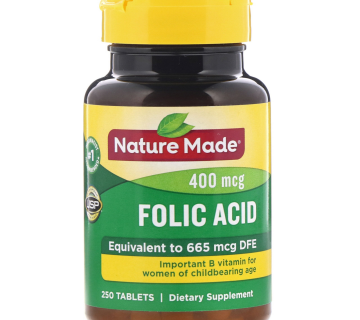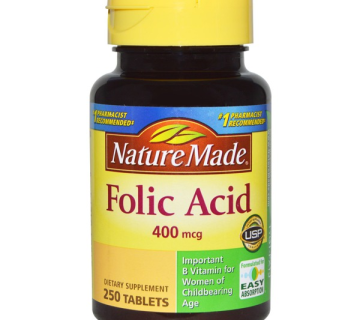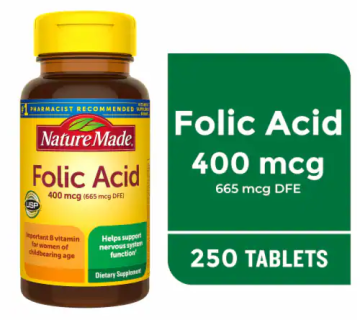
Folic Acid Supplements: Benefits, Foods, Deficiency, and More
Folic acid might sound like something you’d find in a science lab, but it’s actually a superhero nutrient hiding in your food and supplements. Known as vitamin B9, it’s a key player in keeping your body running smoothly—from making healthy red blood cells to supporting a growing baby during pregnancy. Whether you’re curious about its perks, wondering which foods pack the most punch, or worried you might not be getting enough, this guide has you covered. Let’s dive into the world of folic acid and uncover why it’s such a big deal for your health.
What Is Folic Acid, Anyway?
Folic acid is the synthetic version of folate, a B vitamin your body can’t make on its own. Folate shows up naturally in foods like spinach and oranges, while folic acid is added to things like cereal and bread—or popped into a supplement you might take with breakfast. Both forms help your cells grow, repair DNA, and keep your blood in tip-top shape. The catch? Your body absorbs folic acid a bit better than folate from food, which is why it’s a go-to for fortification and pills.
Think of it like this: folate is the farm-fresh version, while folic acid is the souped-up, lab-made upgrade. Together, they’re a dynamic duo that keeps your body humming along. And since you pee out what you don’t use (it’s water-soluble), you need a steady supply to stay on track.
Why Folic Acid Matters: The Big Benefits
Folic acid isn’t just a random vitamin—it’s got some serious bragging rights. Here’s why it’s worth paying attention to:
Keeps Your Blood Healthy
Your red blood cells are like tiny oxygen taxis zooming around your body. Without enough folic acid, they can’t do their job right, leading to a type of anemia that leaves you tired and foggy. Studies show that topping up with folic acid can fix this fast—sometimes in just weeks—by helping your body churn out fresh, healthy cells.
Supercharges Pregnancy
If you’re pregnant or planning to be, folic acid is your best friend. It’s famous for slashing the risk of neural tube defects (NTDs) like spina bifida in babies. These issues happen super early in pregnancy—often before you even know you’re expecting. Research from the CDC says getting 400 micrograms (mcg) daily can cut NTD risk by up to 70%. That’s why doctors push it for anyone who might get pregnant.
Boosts Brain Power
Low folic acid levels have been linked to fuzzy thinking and even dementia in older adults. A 2019 study found that folks taking 400 mcg daily for two years saw sharper brain function and lower levels of proteins tied to Alzheimer’s. It’s not a magic cure, but it might give your mind an edge as you age.
Lowers Heart Risks
Too much homocysteine—an amino acid in your blood—can spell trouble for your heart. Folic acid steps in to break it down, keeping your ticker happy. A big study in China showed that 800 mcg daily dropped stroke risk by 21% in people with high blood pressure. It’s not a guarantee, but it’s a solid perk.
✔️ Quick Tip: Pair folic acid with a healthy diet for max benefits—think leafy greens and lean protein.
❌ Heads-Up: Don’t overdo it—too much folic acid might hide other issues, like a B12 shortage.
Foods That Pack a Folic Acid Punch
You don’t need a supplement to get your folic acid fix—nature’s got plenty of options. Plus, many everyday foods are fortified with it. Here’s the rundown:
Naturally Folate-Rich Foods
- Leafy Greens: Spinach, kale, and romaine lettuce are folate rockstars. A cup of cooked spinach has about 260 mcg—over half your daily goal.
- Legumes: Lentils, black beans, and chickpeas deliver big time. One cup of cooked lentils brings 358 mcg.
- Citrus Fruits: Oranges and grapefruit are tasty folate sources. One orange has around 50 mcg.
- Liver: Beef liver is a folate heavyweight—3 ounces packs 215 mcg. Not your thing? No worries—there’s plenty more to choose from.
Fortified Favorites
Since the late ‘90s, the U.S. has added folic acid to staples like:
- Cereal: Many brands offer 100-400 mcg per serving—check the box!
- Bread and Pasta: Look for “enriched” on the label for an extra boost.
- Rice: A side of fortified rice can sneak in 100 mcg or more.
| Food | Folate/Folic Acid (mcg) | % Daily Value (400 mcg) |
|---|---|---|
| Cooked Spinach (1 cup) | 260 | 65% |
| Cooked Lentils (1 cup) | 358 | 90% |
| Fortified Cereal (1 serving) | 100-400 | 25-100% |
| Orange (1 medium) | 50 | 12.5% |
| Beef Liver (3 oz) | 215 | 54% |
Pro Move: Mix and match—toss spinach into your pasta or pair lentils with rice for a folate feast.
Are You Getting Enough? Spotting a Deficiency
Folic acid deficiency isn’t super common, but it can sneak up on you. Here’s what to watch for and who’s at risk.
Signs You’re Low
- Exhaustion: Feeling wiped out all the time? It might be more than just a long week.
- Mouth Sores: Painful sores or a sore tongue can hint at low levels.
- Brain Fog: Trouble focusing or feeling down could point to a shortfall.
- Pale Skin: If you’re looking ghostly, it might mean your red blood cells are slacking.
Who’s Most Likely to Miss Out?
- Pregnant People: Your needs jump to 600 mcg daily—food alone might not cut it.
- Heavy Drinkers: Alcohol messes with how your body uses folate.
- Folks with Gut Issues: Conditions like celiac or IBS can block absorption.
- Older Adults: Appetite dips with age, and so can folate intake.
A 2023 study found that up to 20% of women of childbearing age in the U.S. don’t hit the 400 mcg mark through diet alone. That’s where supplements or fortified foods can save the day.
Mini Quiz: Are You at Risk?
Answer these quick questions:
- Do you eat leafy greens or fortified foods daily? (Yes/No)
- Are you pregnant or planning to be? (Yes/No)
- Do you drink alcohol regularly? (Yes/No)
If you said “No” to 1 or “Yes” to 2 or 3, chat with your doctor about your levels!
Supplements: Do You Need Them?
Not everyone needs a folic acid supplement, but they’re a game-changer for some. Here’s the scoop:
Who Should Pop a Pill?
- Anyone Who Might Get Pregnant: The CDC says 400-800 mcg daily is a must, even if you’re not planning a baby yet. Why? Half of pregnancies are surprises!
- Pregnant Folks: Bump it to 600 mcg to keep your baby’s spine and brain on track.
- People with Deficiencies: If blood tests show you’re low, 1 mg daily can turn things around.
How to Take It Right
- Pick a Dose: Most multivitamins have 400 mcg—perfect for most people.
- Time It: Take it with breakfast or a snack for better absorption.
- Stick with It: Consistency is key—your body doesn’t store it long-term.
✔️ Smart Move: Pair it with a B12 vitamin to avoid masking a deficiency. ❌ Watch Out: Don’t go over 1,000 mcg daily unless your doctor says so—too much can cause tummy troubles or hide other issues.
The Flip Side: Can You Overdo It?
Folic acid is safe for most, but there’s a catch if you go overboard. Too much (over 1,000 mcg daily) might:
- Hide a vitamin B12 deficiency, which can mess with your nerves.
- Cause mild side effects like nausea or cramps in rare cases.
A 2022 review found no solid link between high doses and cancer risk, but it’s still smart to stick to the recommended amount unless a pro tells you otherwise.
Folic Acid and Pregnancy: A Deeper Dive
Pregnancy is folic acid’s time to shine. Beyond preventing NTDs, it might lower risks like:
- Preeclampsia: A 2021 study suggested it could ease high blood pressure issues in pregnancy.
- Preterm Birth: Some research hints at fewer early deliveries with good folate levels.
Your Pregnancy Plan
- Before: Start 400 mcg at least 3 months before trying.
- During: Keep it up through the first 12 weeks, then aim for 600 mcg total daily.
- After: Breastfeeding? You’ll need about 500 mcg.
Real Talk: One mom I know swore by her prenatal vitamin after her doctor flagged low folate levels—she felt sharper and her baby arrived healthy as can be.
Beyond the Basics: 3 Fresh Angles on Folic Acid
Most articles stick to the usual suspects—pregnancy, anemia, heart health. But there’s more to explore. Here are three under-the-radar topics that deserve a spotlight:
Folic Acid and Skin Health
Ever thought about folic acid for your glow? It helps your skin cells regenerate, which might mean fewer wrinkles or faster healing. A small 2023 study found that people with low folate had more acne flare-ups—hinting that a boost could smooth things out. Try pairing folate-rich foods with a solid skincare routine for a double win.
Could It Ease Restless Legs?
If your legs twitch at night, folic acid might help. A 2024 pilot study showed that folks with restless leg syndrome (RLS) who took 800 mcg daily reported less jiggling after 8 weeks. It’s not a cure, but it’s a promising lead—especially if you’re low to start with.
Folic Acid and Arsenic Detox
Here’s a wild one: folic acid might help flush arsenic out of your system. In places where water’s tainted with this toxin (think parts of Bangladesh), a 2023 trial found that 400 mcg daily cut blood arsenic levels by 13%. It’s niche, but if you’re in an affected area, it’s worth a look.
Your Folic Acid Action Plan
Ready to make folic acid work for you? Here’s how to weave it into your life, step by step:
Step 1: Check Your Plate
- Toss a handful of spinach into your smoothie.
- Swap white rice for fortified brown rice.
- Snack on an orange or a bowl of lentils.
Step 2: Consider a Supplement
- Grab a multivitamin with 400 mcg if you’re not hitting your goal.
- Pregnant? Ask your doc about prenatal options.
Step 3: Know Your Needs
- Aim for 400 mcg daily if you’re an adult.
- Up it to 600 mcg if you’re expecting, or 500 mcg if breastfeeding.
Step 4: Watch for Balance
- Don’t skip B12—think eggs, fish, or a combo pill.
- Keep tabs with a yearly checkup if you’re at risk.
Poll Time: What’s your fave folic acid source? Vote below!
- A) Leafy greens
- B) Fortified cereal
- C) Supplements
- D) Other (spill in the comments!)
Busting Myths: What’s True About Folic Acid?
There’s a lot of chatter out there—let’s clear the air:
- Myth: “You can’t get too much from food.” Truth: Yep, natural folate is safe, but fortified stuff and pills can add up fast.
- Myth: “It’s only for pregnant people.” Truth: Nope—everyone needs it for blood and brain health.
- Myth: “It cures everything.” Truth: It’s awesome, but it’s not a fix-all—balance is key.
A Peek at the Latest Buzz
Folic acid’s been trending lately, especially on platforms like X. Fans of reality star Davi Brito from Big Brother Brazil 25 are hyping his iFood campaign, tying it to healthy eating—and folic acid fits right in. Meanwhile, Google Trends shows a spike in searches like “folic acid benefits for women” and “best folate foods” in early 2025. People want practical tips, and they’re digging into how this vitamin fits their lives.
Real-Life Wins: Stories That Stick
- Jenny, 29: “I started a prenatal with folic acid before trying for a baby. My energy’s up, and my doc says my levels are perfect.”
- Mark, 45: “I had no clue I was low until I felt wiped out. A lentil kick and a supplement fixed me right up.”
- Aisha, 60: “My memory was slipping, but adding fortified cereal to my mornings made a difference—I’m sharper now.”
Wrapping It Up: Your Folic Acid Game Plan
Folic acid isn’t just a buzzword—it’s a nutrient with serious staying power. From keeping your blood pumping to giving babies a strong start, it’s a small thing with big impact. Load up on leafy greens, lean on fortified foods, or pop a supplement if you need it. Just keep it balanced, and you’re golden.
Got a folic acid trick up your sleeve? Share it below—I’d love to hear how you make it work! And if you’re wondering about your levels, a quick chat with your doctor can set you straight. Here’s to feeling your best, one bite (or pill) at a time.


